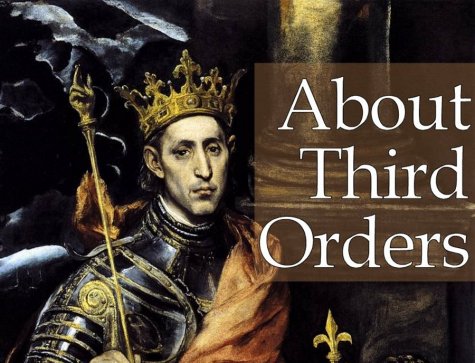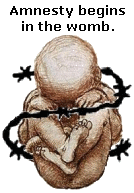A Brief Overview of the Secular Franciscan Order

I frequently get asked, "What's the Secular Franciscan Order all about?" (Runner-up:
"What's that thing you're wearing?" ::pointing to my Tau pendant::) So, I thought I'd share with you my high-level overview of who we are and where we come from.
Someday, when I'm feeling extra-adventurous, I'll do a Franciscan Order family tree diagram ... because who doesn't love drawings that look like spaghetti? (Yeah, it's that involved. :-P ) ANYway ...
To answer the question, "What's the Secular Franciscan Order all about?", we've gotta first go back to St. Francis of Assisi (1181-1226).
History
The First Order
In the 1200s was a dude named Francesco Bernardone (St. Francis of Assisi) who was trying to live the Gospel as faithfully as possible. This attracted a lot of positive attention, and several other dudes said, "Hey, Francesco! We really like what you're doin'. Can we join you?" This led to the creation of the
Order of Friars Minor (Ordo Fratrum Minorum), the First Order in the overall Franciscan Order.
Spaghetti Twist Alert: The First Order later split into three observances: The Order of Friars Minor, the
Order of Friars Minor Capuchin (Ordo Fratrum Minorum Capuccinorum), and the
Order of Friars Minor Conventual (Ordo Fratrum Minorum Conventualium).
The Second Order
A little while later, a young noblewoman, Chiara Offreduccio (St. Clare of Assisi, 1194-1253) saw what was goin' on and wanted to join, too. With Francis' help, she eventually established what's today called the
Poor Clares (Ordinem Sanctae Clarae) (then known as the Poor Ladies), the Second Order ... because it came second. :-P
Spaghetti Twist Alert the Seconde: Within the Second Order, there are many different communities and observances. One of the more well-known ones today is the Poor Clares of Perpetual Adoration, the
community to which Mother Angelica of EWTN belongs.
The Third Order
A little while after
that, in 1221, a married couple, Bl. Luchesio and Buonadonna of Poggibonzi (both died in 1260), also wanted to join the party. (Ain't no party like a Franciscan party!) So, they approached Francis and said, "Yo! We want in! But, we've got worldly responsibilities that we just can't ditch. Plus, as you can see, we're married and we'd really like to stay that way. Can you do anything for us?"
Francis, being a very creative fellow, came up with the Brothers and Sisters of Penance, the Third Order ... 'cause it came third. (See a pattern here?) Today, it's known as the
Secular Franciscan Order (Ordo Franciscanus Saecularis).
In case you're wondering what's the deal with the term "secular": Unlike religious brothers and sisters, those in secular orders (also known as third, tertiary, or lay orders) don't remove themselves from the world but stay in their own homes, families, and jobs -- that's where the term "secular" comes in. Faithful and practicing married or single Catholic men and women from all walks of life are able to join secular orders (as can diocesan priests and deacons).
For more information on third/secular orders,
I compiled some info. explaining them, and some links to other third/secular orders.
Spaghetti Twist Alert the Thirde: Over time, Secular Franciscans began living together in communities, and eventually formed into religious orders. This became the
Third Order Regular (Tertius Ordo Regularis).
... See what I mean by spaghetti, peoples?!
Who We Are/What We "Do"
For more general info. on our order -- which is a
real order in the Church -- check out
this welcome letter from the National Minister of the order in the U.S.
To go deeper, see this
fabulous explanation of who we are and what we're all about:
"A Specific Vocation for A Particular Mission" by Benedetto Lino, OFS (it's a PDF; sorry).
... And yes,
we wear habits. Always have. :-)
Labels: franciscan, ofs, third order regular, third orders
What's with the "OFS" and "SFO" after your name?

If by some strange sickness, you go lookin' through older posts and comments here, you'll see the acronym "SFO" after my name. However, more current ones have "OFS". Any normal person would see this and say, "Huh?" So, I 'splain it for you.
Folks in orders (religious
and seculars) put their orders' acronyms after their names to indicate their membership in said orders. For example, "Brother John Smith,
OP" indicates that he's a member of the
Order of Preachers (Ordo Praedicatorum, "OP"). "Sister Jane Doe,
FSP" indicates she's a member of the arse-kickingly awesometastical
Daughters of Saint Paul (Figliae Sancti Pauli, "FSP").
As you can see in these examples, the abbreviations correspond with the
Latin form of the names. That way, everyone, regardless of country/language, has the same acronym, which emphasizes the universality of the order and has the side benefit of reducing confusion.
Now, for those of us Secular Franciscans in
English-speaking countries, we
used to list the
English abberviations -- "SFO" for "
Secular Franciscan Order" -- after our names. However, everyone
else used the proper "OFS" -- for
Ordo Franciscanus Sæcularis -- after their names. And as you can imagine, it caused continual confusion, along with fragmenting our identity.
Finally, late last year (2011), Rome said*, "Hey, enough! Use 'OFS' like everyone else!", which was A Very Good Move. So, since then, we've all been switching to "OFS". Naturally, it's taking awhile for the changes to propagate everywhere, so you'll still see "SFO" references and stuff all ova' the place. But, we'll get there, eventually. We've been around since 1221, so yeah, we're used to adapting. ;-) Oh, bonus trivia tidbit: We were orignally called "The Brothers and Sisters of Penance".
So, now you know. And knowing is half the battle. Go forth and win at Trivial Pursuit!
- - - - -
* Ordo Franciscanus Sæcularis,
2011 General Chapter: "The Official Name of the Order" (PDF)
Labels: ofs, third orders, vocations
Catholicism's best-kept secret: Third orders

Image detail from St. Louis King of France with a Page by El Greco (1590). King St. Louis IX was a Secular Franciscan and is the co-patron of the Secular Franciscan Order.
Click here to save this post on Pinterest.
Are you a Catholic who feels attracted to a religious order, but are married? Do you want to stay in your home and at your job, but still follow a rule of life, like that of St. Benedict, for example? Do you want to share your pilgrim journey with other like-minded people? Have I got a deal for you: Third orders!
What are Third/Secular Orders?
According to the
New Advent Catholic Encyclopedia, "Third Orders signify in general lay members of religious orders, i.e. men and women who do not necessarily live in community and yet can claim to wear the habit* and participate in the good works of some great order. ... Any Catholic may join a Third Order, but may not at once belong to more than one, nor may he without grave cause leave one for another."
(* I can't speak for others, but we Secular Franciscans do wear habits.)
Here's the
Code of Canon Law's definition: "Associations whose members share in the spirit of some religious institute while in secular life, lead an apostolic life, and strive for Christian perfection under the higher direction of the same institute are called third orders or some other appropriate name." (Can. 303)
For more information, see the following general resources:
Who Joins Third/Secular Orders?
Married or single Catholic women and men from all walks of life are able to join secular orders, as are diocesan priests and deacons. Like their religious counterparts, seculars (also called "tertiaries") undergo a period of formation according to the processes established by their orders, after which they become professed members. Profession for seculars means they promise to live according to the rules of their orders; it does
not consist of taking vows.
What Does "Secular" or "Third" Order Mean?
Unlike religious (monks, friars, nuns, sisters) who remove themselves from the world and live apart in convents or friaries, those in third orders stay where they're at in the world (homes, jobs, families, etc.); hence, the term "secular". For example, as Bernard of Bessa, Secretary of St. Bonaventure, said, "The intention of [Secular Franciscans] is to live honorably in their residences and to busy themselves with pious actions and to flee from the vanities of the world."
You also see "third" used, a term which arose as an indicator of when the lay branch of the main order was established. For example, the
Franciscan Order started with a group of men, whom St. Francis of Assisi organized into the Order of Friars Minor -- the
first order. After a time, a
second order for nuns -- the Poor Clares -- was established. Finally, a
third order was established for the laity -- the Secular Franciscan Order.
Links for Third/Secular Orders
Last updated 16-Jul-2014
If you'd like to learn more, check out the following links. I'm not sure that everything listed meets the criteria of being an actual third/secular order, but it's at least something to look into! Also, while oblates are not technically tertiaries, I've included them here, since they're still a way for laity to associate with religious orders. :-)
Please feel free to share any information, or corrections, you may have in the comments.
NOTE: Some of these sites are NOT in full compliance with the Church's Magisterium, so please exercise caution when surfing. I've included them for contact/informational purposes; it doesn't necessarily mean I endorse 'em!
Labels: third orders, vocations




 If by some strange sickness, you go lookin' through older posts and comments here, you'll see the acronym "SFO" after my name. However, more current ones have "OFS". Any normal person would see this and say, "Huh?" So, I 'splain it for you.
If by some strange sickness, you go lookin' through older posts and comments here, you'll see the acronym "SFO" after my name. However, more current ones have "OFS". Any normal person would see this and say, "Huh?" So, I 'splain it for you.
